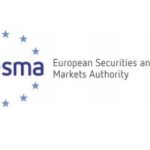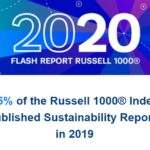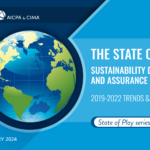
In light of the increased spotlight on environmental, social and governance (“ESG”) disclosures, White & Case’s Public Company Advisory Group conducted a survey of environmental and social (“E&S”) disclosures in the Securities and Exchange Commission (“SEC”) filings of the top 50 companies by revenue in the Fortune 100. Our survey focused on 15 categories of common E&S-related disclosures in Annual Reports on Form 10-K and annual meeting proxy statements filed with the SEC in 2018 and 2019. The trends from our survey and key takeaways are discussed below.
Increase in E&S Disclosure from 2018 to 2019
Forty-seven of the companies surveyed (or 94 per cent) increased their E&S disclosures in Form 10-Ks and proxy statements between 2018 and 2019. The most significant increase in E&S disclosures came in the seven E&S categories described below.
The Seven E&S Topics on the Rise in 2019
 Human Capital Management (HCM)
Human Capital Management (HCM)
The largest increase in E&S disclosures came in disclosures on HCM. Overall, 41 of the 50 companies surveyed (or 82 per cent) included some form of HCM disclosure in their 2019 Form 10-K or proxy statement, and one-quarter of the 2019 filings surveyed (or 25 filings), including 22 of the 2019 proxy statements surveyed (or 44 per cent), showed an increase in this type of disclosure from 2018. In the 25 filings where there was an increase in HCM disclosure, the disclosure included the following4:
On Employee Diversity (in 21 of the 25 filings). For example: “We are proud that over 60 per cent of our employees are women or people of color, that over half of our employees report to a woman or a person of color and that women and people of color represent more than 50% of our employees at or above the vice president-level.”
On Employee Training (in 15 of the 25 filings). For example: “Through the end of 2018, 60 percent of [our] management workforce had enrolled in reskilling programs provided or subsidized by the company. And more than 50,000 learners worldwide, including more than 5,000 [of our] employees, had enrolled in nanodegree credential programs, a new pathway to higher education…”
On the Importance of HCM to Corporate Success (in nine of the 25 filings). For example: “[HCM] is critical to ongoing business success… “human energy” is the most important element of delivering reliable, affordable and ever-cleaner energy – which requires investing in our people. We strive to create a highly engaged and motivated workforce where employees are inspired by leadership, engaged in purpose-driven, meaningful work, have growth opportunities, and thrive in an environment that embraces diversity and inclusion.”
On Employee Pay/Benefits (in nine of the 25 filings). For example: “We pay employees competitively compared to other opportunities they might have in the market. We also offer competitive benefits to promote the health and happiness of our employees, provide unique perks that make life and work more convenient, design compelling job opportunities aligned with our mission, and create a fun and energizing work environment.”
On Employee Feedback (in three of the 25 filings). For example: “We conduct an annual employee survey to understand employees’ views…and measure the impact of our people development programs. An effective approach to [HCM] requires that we invest in talent, training, culture and employee engagement.”
Corporate Culture
Twenty-two of the 2019 filings surveyed (or 22 per cent), including 18 of the 2019 proxy statements surveyed (or 36 per cent), increased disclosure on corporate culture from 2018. Overall, 35 of the companies surveyed (or 70 per cent) included disclosure on corporate culture in their Form 10-K or proxy statement in 2019.
Culture and Employee Engagement (in 11 of the 22 filings). For example: “Our culture reflects how we run our company every day. We put the customer first, emphasize integrity and responsibility, and actively encourage all employees to bring their whole selves to work. When we create a workplace where our colleagues are engaged, empowered, and committed for the long term, we are better positioned to help our clients improve their financial lives.”
Importance of Board in Shaping Culture (in eight of the 22 filings). For example: “Our Board and its committees play a key role in oversight of our culture, setting the ‘tone at the top’ and holding management accountable for its maintenance of high ethical standards and effective policies and practices to protect our reputation, assets, and business.”
Culture in Quotes from Company Leadership (in three of the 22 filings). For example: “Culture is everything to me. When people love what they do and the place they work, their best ideas come to life to improve our organization, our services, and our world. I want people to be encouraged to take risks, to try new things, and to be willing to fail—and that comes from a strong culture.”
Supply Chain Management
Twenty-one of the 2019 filings surveyed (or 21 per cent), including 16 of the 2019 proxy statements surveyed (or 32 per cent) and five of the 2019 Form 10-Ks surveyed (or 10 per cent), increased their disclosure related to supply chain management from 2018. Overall, 34 of the companies surveyed (or 68 per cent) included this type of disclosure in their 2019 filings.
Environmental Impact (in 12 of the 21 filings). For example: “Through our supply chain initiative, the Partnership for A Cleaner Environment (PACE), we shared our best practice examples with 50 suppliers, to minimize our overall environmental impact.”
Supplier Diversity (in seven of the 21 filings). For example: “We also continue to work toward our goal of reaching $1 billion in annual spending with diverse-owned suppliers by 2020, and are investing in programs to create new career pathways into the technology industry.”
Policies (in five of the 21 filings). For example: “Our Principles of Conduct for Suppliers outlines expectations for working with [our company], and covers topics including sustainable business practices, diversity, conflict minerals, ethics and labor rights, and we score and measure progress. Every new contract agreement with suppliers requires they acknowledge the principles.”
Human Rights (in three of the 21 filings). For example: “[We are] proud to be a leader in promoting respect and support for human rights across our operations—from our supply chain to our products…In particular, we are committed to efforts to prevent forced labor where we operate…”
Environmental Matters
Nineteen of the 2019 filings (or 19%), including 15 of the 2019 proxy statements surveyed (or 30%) and four of the 2019 Form 10-Ks surveyed (or 8%), increased their environmental disclosure from 2018. Overall, nearly all of the companies surveyed (46 or 92%) included environmental disclosure in their 2019 Form 10-K and/or proxy statement.
Investments in Environmental Sustainability (in eight of the 19 filings). For example: “We are investing $11 billion to put hybrid and fully electric vehicles models on the road by 2022, as well as responsible development of the self-driving car.”
Climate Change (in six of the 19 filings). For example: “…[L]ast year we signed agreements to purchase 820MW of wind power annually, making [us] one of the largest corporate purchasers of renewable energy in the U.S. In 2019, we plan to…take steps to improve our company’s climate resiliency…[Our] wind projects are expected to reduce greenhouse gas emissions equivalent to taking more than 530,000 cars off the road or providing electricity for more than 372,000 homes per year.”
Eco-Friendly Buildings/Facilities (in three of the 19 filings). For example: “Our global headquarters is LEED Gold Certified and features vegetated green roof areas which reduce stormwater runoff while decreasing energy consumption and reducing the heat island effect.”
On How Environmental Issues Tie to Business Success (in two of the 19 filings). For example: “Sustainable practices and a focus on environmental responsibility aren’t separate from our primary business: they are integral to the work we do every day to serve customers and create value for stockholders.”
Social Impact and Community
Tied with environmental matters, 19 of the 2019 filings surveyed (or 19), including 17 of the 2019 proxy statements surveyed (or 34 per cent) and two of the 2019 Form 10-Ks surveyed (or 4 per cent), increased their disclosure related to social impact and community relations, as compared to 2018. Overall, 41 companies surveyed (or 82 per cent) included social impact and community disclosure in their 2019 filings.
Charitable Giving (in ten of the 19 filings). For example: “[Our] Foundation…is committed to transforming our communities and shaping the diverse workforce of tomorrow by leveraging the power of [our company]… The program supports giving by employees by providing a 1:1 match, up to $5,000 per employee…with gifts matched in 2018 totaling $59 million.”
Education (in nine of the 19 filings). For example: “For more than 40 years, [we have] worked alongside educators to unleash the creative potential in every student. We launched Everyone Can Create to help bring creative expression into the classroom…We continue to work closely with schools to raise the bar for what’s possible for learning with technology and to prepare students for a rapidly changing world.”
Technology (in six of the 19 filings). For example: “We are at the forefront of new technologies—such as AI, autonomous driving, and 5G wireless broadband—that are increasingly being used to empower individuals, companies, and governments around the world to solve major societal challenges. Simultaneously, we are empowering people through education and advancing social impact initiatives, helping us build trust with key external stakeholders and support the interests of our employees.”
Board Oversight of E&S Issues
Sixteen companies (or 32 per cent) increased disclosure on board oversight of E&S issues in their 2019 proxy statements. Overall, 43 companies (or 86 per cent) included board oversight of E&S issues in their 2019 proxy statements.
ESG Committee or Function Reporting to the Board (in eight of the 16 filings). For example: “The Company also formed a new sustainability function in 2018 to ensure a strategic, coordinated approach in this important area. This function will provide periodic updates to the Board on the Company’s sustainability strategy and efforts, and environmental and social issues management and reporting…The creation of this sustainability function is consistent with this developing investor focus and a desire for better reporting among current and potential shareholders.”
Governance Committee Oversight of E&S (in seven of the 16 filings). For example: “The Board has delegated oversight responsibility over [the company’s] corporate responsibility matters to the Nominating & Governance Committee. The Vice President of Corporate Responsibility and the Corporate Responsibility team work with functional leaders across the company to determine strategies, policies and goals related to corporate responsibility and sustainability and regularly report to and seek input from the Nominating & Governance Committee on those matters, including review of the annual Corporate Responsibility Report.”
E&S Issues in Shareholder Engagements
Fourteen companies (or 28 per cent) increased their disclosure related to E&S issues in shareholder engagements in their 2019 proxy statements. Overall, 37 companies (or 74 per cent) included disclosure on E&S issues in shareholder engagements in their 2019 proxy statements.
Responsiveness to Shareholder Feedback (in 5 of the 14 filings). For example: “The Board and management carefully analyzed the results of the voting at the 2018 annual meeting, and at the Board’s direction, the Company initiated an expanded environmental, social and governance engagement program with our institutional shareholders.”
ESG Engagements Increasing (in 2 of the 14 filings). For example: “In 2018, the Company held shareholder engagements on [ESG] matters with institutional investors, pension funds, and labor, religious, and nongovernmental organizations representing more than 1.3 billion shares, or approximately 30 percent of total shares outstanding and 55 percent of institutional shareholdings. The number of engagements with shareholders on environmental, social, and governance issues has more than doubled since 2014.”
10-K vs. Proxy Statement Breakdown
E&S disclosure was more common in the proxy statements of the surveyed companies than in their Form 10-Ks, with the increase in E&S disclosure approximately five times more likely to come in a proxy statement than in a Form 10-K. In proxy statements, the greatest increase in disclosures were in the categories of (1) human capital management, (2) corporate culture and (3) social impact and community. With respect to Form 10-Ks, the E&S topics that saw the highest increase in disclosures were (1) supply chain management, (2) environmental matters and (3) corporate culture.
Qualitative vs. Quantitative E&S Disclosures
In the White & Case survey, we also reviewed whether the disclosure was only qualitative or both quantitative and qualitative in nature. We found that a majority of E&S disclosures in the SEC filings we reviewed were qualitative and did not provide quantitative metrics; however, certain E&S categories had more quantitative disclosure than others (for example, disclosure on environmental matters, HCM and social impact and community were more likely to contain quantitative metrics, as compared to disclosure on corporate culture or ethical business practices). Our survey also found that an increasing number of companies have added some quantitative information to their E&S disclosure, particularly with respect to certain categories, such as HCM and environmental matters. For some companies, as described below, the question is also where any relevant quantitative E&S information will be provided – in a sustainability report or SEC filing.
SEC Filings vs. Sustainability Reports
The trend towards increased E&S disclosure in SEC filings is pronounced. Investors have increasingly focused on and called for ESG disclosure, as there has been an historic shift in investors’ approach to these issues. Companies should assess their investors’ policies and consider engaging with investors in order to determine what ESG information about the company is important to them. However, once a company knows what to disclose to its investor base, the nuance is to carefully consider where to place the E&S disclosure. Investors seeking ESG information do not necessarily expect any or all of that information to be presented in SEC filings, and sustainability reports and other website disclosures can provide effective vehicles for this disclosure.
Key Takeaways
Given these considerations, when contemplating any ESG disclosure in connection with their SEC filings, public reporting companies should give due consideration to the following three key takeaways:
1. Consider SEC Guidance
In a recent speech, SEC Division of Corporate Finance Director William Hinman emphasized the SEC’s principled materiality disclosure framework and also encouraged companies to consider disclosure “on all emerging issues, including risks that may affect … long-term sustainability.”
2. Focus on Materiality
In the end, the decision whether to include ESG information in an SEC filing or instead provide it in a sustainability report or website is a nuanced one and should be made with care. Public companies should be assessing ESG matters facing their businesses well in advance of their SEC filings and confirming whether any of these matters present material risks to their businesses that need to be addressed in SEC filings. When E&S information is not material, it may not be advisable to add the information to an SEC filing for a number of reasons, including the heightened liability risk with respect to disclosure that is filed with the SEC. Companies should therefore carefully weigh the risks and benefits when adding this type of disclosure to their SEC filings.
3. Make Sure Your ESG Disclosure is Accurate and Consistent
The ESG information that is disclosed in voluntary sustainability reports and SEC filings must be accurate and consistent. In fact, Hinman noted that the SEC is “actively” comparing the information companies voluntarily provide with the information disclosed in SEC filings. Accordingly, companies should take steps to ensure that they have controls in place to effectively process, summarize, assess and review the accuracy of all of their ESG disclosures.



